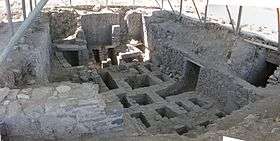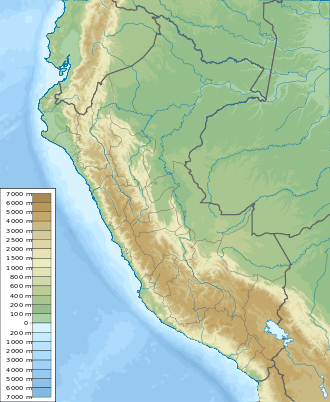Huari (archaeological site)
Huari[1] or Wari[2] is an archaeological site located near the town of Quinua, 22 km northeast of the city of Ayacucho, in the Ayacucho Region, Peru at an elevation between 2600 and 2900 meters.[2] It was the capital city of the Huari Empire and one of the largest urban settlements in ancient Peru.[2]
 A tomb at Huari | |
 Shown within Peru | |
| Location | Huamanga Province, Ayacucho |
|---|---|
| Coordinates | 13°03′38″S 74°11′56″W |
| Type | Settlement |
| History | |
| Founded | 400 AD |
| Abandoned | 1000 AD |
| Periods | Middle Horizon |
| Cultures | Huari culture |
History
Huari was founded ca. 400 AD, gaining prominence around 550 AD.[1] During its maximum development, the city was inhabited by around 70.000 people.[1][2] As this site was inhabited by people from different cultures, it was the center of a new religion that synthesized the beliefs of those peoples.[1] The city was abandoned ca. 1000 AD.[1]
Layout
The archaeological site spans an area of 2000 hectares, and comprises several areas or neighborhoods.[2] Buildings are made of stone and mudbrick, and painted in red and white.[2] Many of the structures had residential, administrative or religious purposes.[2]
See also
- Cultural periods of Peru
- Chuqi Pukyu
- Northern Wari ruins
- Wari Empire
References
- Jennings, Justin (2010). Globalizations and the Ancient World. Cambridge University Press. pp. 99, 103–105, 118.
- "COMPLEJO ARQUEOLÓGICO WARI" (in Spanish). Mincetur. Retrieved 2018-09-20.